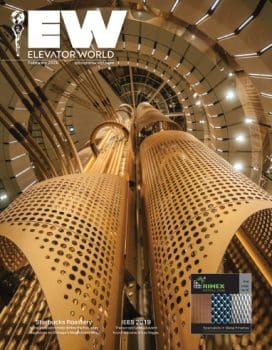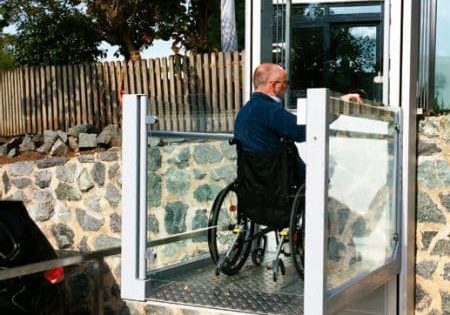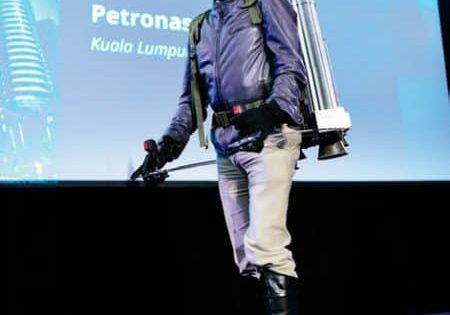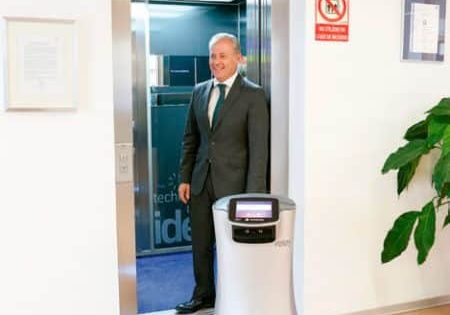Rising to the Challenge
Feb 1, 2020
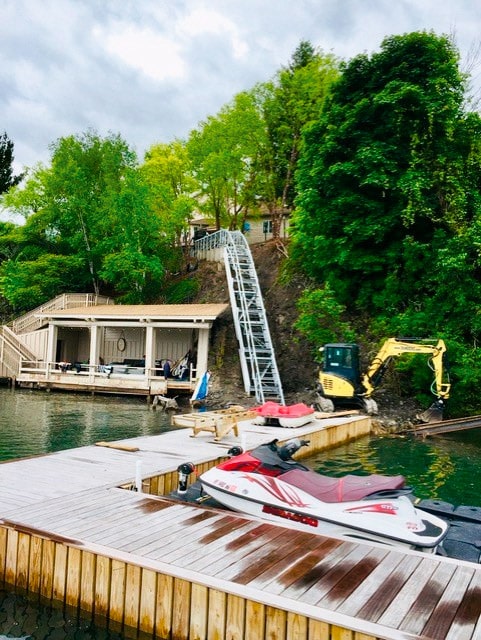
Curved inclined elevator helps family of disabled former athlete enjoy their lake home together.
by Bill MacLachlan
The Finger Lakes region of Upstate New York is arguably one of the nation’s most beautiful places to live, and the crown jewel of the Finger Lakes is Lake Skaneateles in Skaneateles, New York. This 8,800-acre lake, known for its clean and clear waters, is a draw for tourists and those wanting to build dream houses in a place where recreational boating and other water activities are readily available. Many of these dream houses are built up on hills that offer impressive views of the lake below, but those views often come with a tradeoff: the steep incline makes it difficult to access the water. While a set of stairs is an obvious solution, even this can be challenging, if not downright impossible, for people living with physical disabilities.
A family in Skaneateles chose Orono, Minnesota-based Hill Hiker, Inc. to manufacture and install a private-residence inclined elevator to solve just such a challenge, so the client’s family and friends could easily manage the steep hillside that leads from the main house to the boat house at the lake elevation.
The client was thrown a true curve ball in life. Once a professional athlete and public figure, he is now living with a debilitating neurological disorder that makes the steep stairs to the lake very difficult, if not impossible, for him to use. His family, looking to prioritize their time with their father, decided to get him the inclined elevator as a gift so they could continue to enjoy the lake together. Part of the arrangement was that the elevator be installed in time for Father’s Day 2019. Hill Hiker delivered on this timeline, and the family was able to access the lake again, just as they had on previous Father’s Days.
Tough Terrain
The main challenge of this installation was the topography of the site. A substantial change in the incline angle midway down the hill created a need for a curved rail system with a mechanical leveling system to keep the car level from the top of the hill all the way to the bottom. Hill Hiker engaged engineering, planning and design firm VAA, LLC to collaborate on the structural design. Using Revit 3D Modeling software, Hill Hiker and VAA created a 3D model of the site, which enabled the engineers and installers to virtually “run” the car through the curve and ensure everything would work as planned.
The general contractor for the project was Trident Shoreline Environmental Services of Skaneateles.
The top landing of the elevator is level with the first floor of the house. As the car begins its travel, it proceeds down a 9° slope descending the hill. At approximately the 80-ft mark, the angle of incline changes to more than 41° and travels for the next 30 ft. For the final 36 ft, the elevator maintains a steep, 41° journey to the bottom landing. As the car travels through the curve, a second set of wheels and channels gently raise the downhill end of the car to keep it level across the curve transition and to the bottom landing on the lake shore.
The system has hardwired call stations at each landing, plus full directional controls with wireless operation onboard the car. An enhanced repeater was installed to ensure the wireless system would not lose communication along the track’s curve. The in-car controls utilize a 900-MHz spread-spectrum digital wireless system, eliminating the need for a traveling cable, which would be subject to potentially damaging outdoor conditions, such as temperature extremes, wind, rain, snow, humidity and ultraviolet radiation. While the possibility of cracked or broken cables creating rogue signals can be a serious concern for inclined elevator applications, the robust nature of commercial wireless technology facilitates constant communication between the battery-operated transmitters in the car and the hardwired receiving unit in the elevator controller at the top of the hill. This eliminates the possibility of rogue signals or failed button commands. The elevator will not operate with a dead battery until it is replaced.
Transportation System Details
Hill Hiker manufactured and installed the entire Hill Hiker Hillside Lift. The length of travel is 146 ft with a vertical rise of 45 ft. It travels at a speed of 59 ft/min and serves two stops. The drive machine is a single-cable winding drum that, through a series of deflection sheaves, pulls the car through a C-channel rail. The chassis holds two sets of safeties: an overspeed centrifugal governor wheel, which rides with the car, and a slack cable or broken-rope safety connected to the main hoisting cable. A mechanically resettable safety switch is mounted near the motor/drum assembly to cut motor power and engage the brakes in the event the cable goes slack. Electric contacts and mechanical locks are installed on both landing gates and the car door.
The car is a 51-1/8-X-67-5/8-in., open-construction cab mounted to a 3-X-5-ft chassis. The track and car are constructed of 7-ga. standard steel, and the car is suspended by 3/8-in. galvanized aircraft cable with a rated breaking strength of 14,400 lb. The onboard controls, including directional buttons, a stop button and a door-open safety circuit, are operated through wireless communication.
The landing controls include hardwired buttons at each landing, protected by a keyless entry pad. The control panel is UL-508A listed and includes a variable-frequency drive and programmable logic controller designed for seamless, safe operation. Hill Hiker utilizes solid-state, quick-disconnect-style proximity deceleration limit switches for maximum weather resistance. All electrical enclosures, buttons, switches and other components have a minimum of NEMA 4X weather ratings.
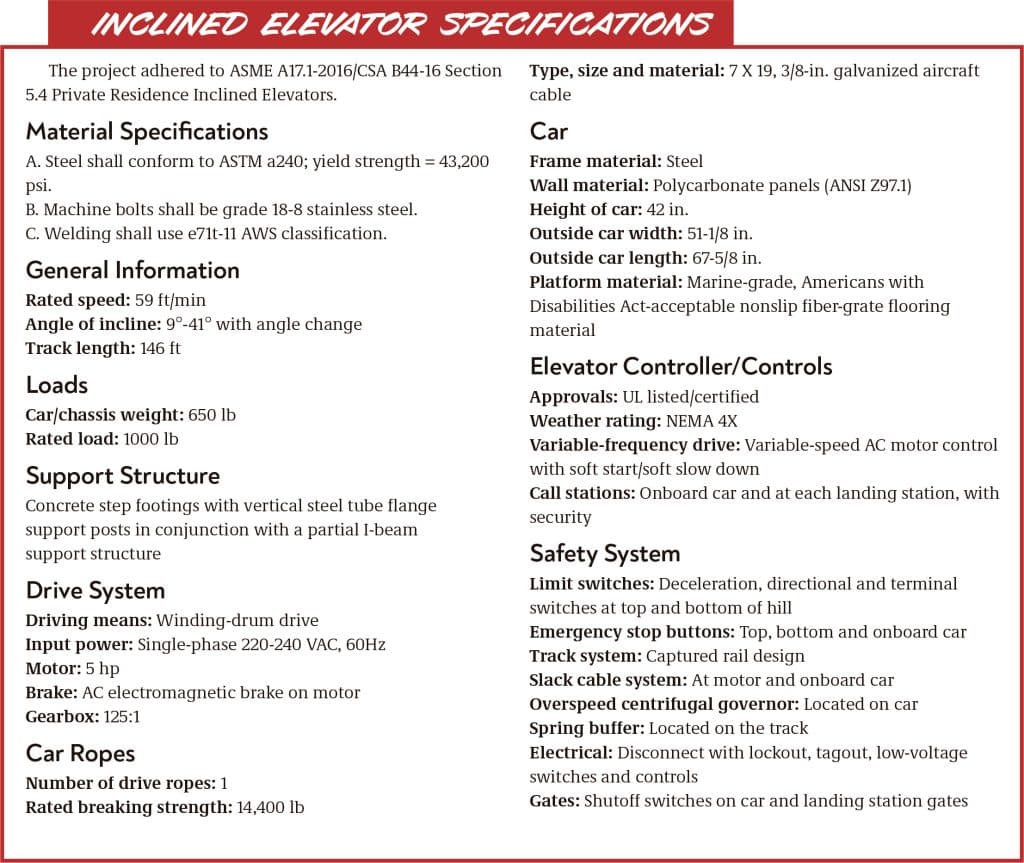
Get more of Elevator World. Sign up for our free e-newsletter.

